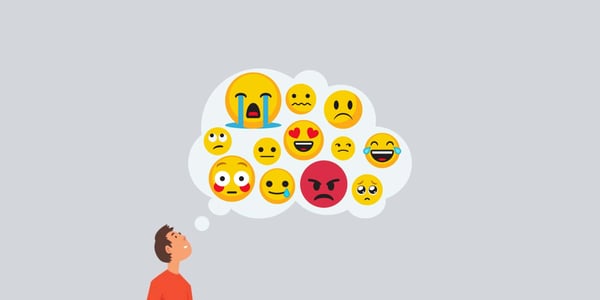Growing up, I was taught that moving through the world as if nothing fazed me was a true sign of strength. I did this exceptionally well at first, but my negative thoughts inevitably crept up on me, eventually consuming me. Rather than address these struggles, I suppressed them and hoped they’d eventually fade away.
But the older I became, the harder it was to pretend I wasn’t overwhelmed by my inner dialogue. So I went to therapy for help.
For many people, the concept of “feeling our emotions'' is already hard to accept and practice. And for those with attention-deficit/hyperactivity disorder (ADHD) - as well as those with autism - this can be compounded with things like rejection sensitive dysphoria, or RSD.
Not everyone with ADHD experiences RSD to the full extent — but for those that do, the emotional (and sometimes physical) pain can be debilitating. This won’t improve overnight, but with a bit of helpful tips on our end and determination on your end, we can gain more control of our emotional responses.
Let's explore some valuable insights and strategies for rejections sensitivity and emotional regulation that are frequently discussed in therapy.
What does "mindfulness" mean?

Mindfulness is the practice of heightening your awareness of the present moment — surroundings, stimuli, and most importantly, the emotions or thoughts you have in that moment.
The catch?
You have to do it without judging yourself! (Easier said than done)
Over time, mindfulness can teach you to recognize any negative or unhelpful emotions. And eventually, it can help you transition from dwelling in the past... to projecting into the future. People usually associate mindfulness with meditation, but that's not always necessary. There are other ways to achieve mindfulness, such as the R.A.I.N. method.
Is mindfulness a religious thing?
Not really! Though its origins are in eastern philosophy and Buddhism, there aren't any religious components that you're required to believe in or acknowledge in order to fully benefit from mindful practices. Mindfulness is for anyone and everyone with a mind.
The R.A.I.N method

What is the R.A.I.N. method and what is it used for?
The R.A.I.N. method is a useful framework to use when we experience difficult emotions. In the times where we’d normally surrender to our overwhelming anger or anxiety, the R.A.I.N. method serves as a guide to help us navigate our emotions while teaching us about ourselves in the process.
The R.A.I.N. acronym stands for:
- Recognize
- Allow
- Investigate
- Nurture
Using the R.A.I.N. method for ADHD
People with ADHD may benefit from this strategy because they tend to commonly struggle with emotional dysregulation, which can manifest as rejection sensitive dysphoria, anger problems and angry outbursts, and extreme anxiety.
In fact, researchers have explored the effects of mindful practices on ADHD brains, and they concluded that mindful practices can ease emotional sensitivity in neurodiverse individuals.1
Breaking down R.A.I.N. to build up Y.O.U.
Let's break down the R.A.I.N. method to better understand it, and then you can decide if this is something that you'd like to try on your own!

R - Recognize
In the first step, you recognize what’s happening around you and take note of your emotional response. The point of this is to make yourself more consciously aware of the feelings, thoughts, and behaviors that arise... without judgment.
💡 Pro-Tip! An emotion wheel could be an excellent tool to help with naming your emotions. (Choosing a word for the way you feel can be challenging!)
❓ Example: I’m worried my friend dislikes me after I made a joke that hurt their feelings. Using my emotion wheel, I recognize that I’m afraid they may abandon me after this. But I’m also angry and annoyed that they didn’t understand that it was a joke in the first place.
A - Allow
Allow the thought or emotion to simply exist. Don’t push it away. Don’t change it. Don’t judge it.
Just let it exist.
You don’t have to agree with your internal monologue; just hold a safe space for them to pass through. This will eventually become second nature, and you may notice an increase in energy. Why? Because you’re no longer draining your mental energy by fielding, analyzing, and judging every single emotional thought that passes through your mind.
❓ Example: Instead of telling myself how I should be feeling about this situation, I’ll just let these emotions run their course without blocking or judging them. Though they are uncomfortable, they are present and valid.
⚠️ Heads up! This step may be difficult for those who have conditioned themselves to compartmentalize their emotions, or for those who have experienced trauma. It was also difficult for me because I’ve spent my whole life deflecting, changing, and judging my own emotions.
I - Investigate
Let’s dig a little deeper now that we’ve had time to sit with our thoughts and emotions. Even though they may seem straightforward at first, exploring them with intention can help to uncover their roots.
Ask yourself these investigative questions:
- Why do I feel this way?
- Is there an underlying truth or unresolved problem that my emotions are guiding me to?
- What else might be influencing me to feel this way?
From here, you can take things a step further by asking yourself what your needs are at that moment.
❓ Example: I probably feel like my friend is mad at me because they’ve been distant lately. But if I’m being honest with myself, they’ve never given me any reason to suspect they’d abandon me. Perhaps this has more to do with my insecurities…
💡 Pro-Tip! You don’t have to use the above questions word-for-word. What’s important is the purpose of the questions: to explore the subconscious layers of your emotions.
N - Nurture
Note: "non-identification" can also be used in place of "nurture"
You’ve identified and explored your unhelpful thoughts and difficult emotions. Great work!
The final step is to separate them from you — your sense of self, your identity, and your self-worth. The emotions you feel may seem like they are a real part of you, but know that they are not you. And they’re certainly not the only aspect of you that matters.
❓ Examples: I feel afraid, but I’m still courageous. I feel insecure, but I’m still loved. I feel sad, but I can still appreciate others’ happiness.
⚠️ Heads up! This step takes the longest to master. Changing the way we view ourselves is no easy task. But the good news is that it’s totally possible to separate your feelings from your sense of self, reach the point of self-acceptance, and live your best life.
Final thoughts: you got this
The next time you feel like you’re on the verge of a mental breakdown, try to remember our breakdown of the R.A.I.N. method. Take it from someone who initially scoffed at the idea of “mindful practices”... The R.A.I.N. method is a game-changer.
The more I practice, the easier it becomes to pinpoint my emotions. There is always room for improvement, but the troubling thoughts and emotions that used to be deafening? They’re merely whispers these days.
But if you try it out and it doesn’t work for you, don’t panic! It’s just one of the many tools at your fingertips. But — the simple fact that you’re here at the end of this article tells me you’re already on your way to finding what will work for you.
No matter what method you use to practice mindfulness, they all come with a learning curve. Many of us haven’t conditioned ourselves to reflect on our mind and what goes on in there, so it’s normal for the process to feel uncomfortable at first.
But — that discomfort you’re feeling?
It means you’re growing.




.jpg)


